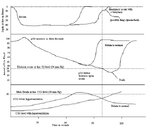It has been a while since I put this graph up on Scubaboard, but I'm pretty sure I did this in the past. Every so often, it must be re-done though.
Hyperventilation doesn't do anything to increase the amount of oxygen in the bloodstream. What it does is to blow off carbon dioxide (CO2) from the bloodstream. It is the level of CO2 in the bloodstream which signals that the diver "must breath." This occurs at about 50mm Hg (mercure) partial pressure in the blood. By hyperventilating, the normal level of CO2 in the bloodstream is decreased, and therefore the "must breath" signal is postponed.
Blackout occurs at about 34 mm Hg partial pressure in the blood for oxygen. The hemoglobin can saturate to nearly 100% oxygen carrying capacity, but when it is used by the body and brain, it goes down. The extent depends upon things like how relaxed the diver is in the water, how fast the diver tries to swim, unexpected exertions (fighting a lobster, for instance).
Normally, if you look at the third level graph of CO2 levels, the "must breath" signal preceeds the moment where the oxygen level gets to blackout phase. The diver surfaces (see the top graph where the diver surfaces before the vertical line for blackout). But if the diver hyperventilates, that "must breath" signal is pushed back time-wise, sometimes beyond the blackout line. This can be compounded by depth, as the oxygen levels will be okay at depth due to the increased partial pressure with depth. But as the diver ascends, that pressure lessens, and the oxygen level in the blood can then reach the blackout line before the diver reaches the surface, which is why it is called "shallow water blackout." It occurs on the ascent as the partial pressure is released and the oxygen level in the blood falls, typically between 20 and 10 feet of depth, e.i. "shallow water."
SWB can also happen on a shallow dive, when the diver experiences the urge to breath and, with the lowered percentage of CO2 from hyperventilation, stays underwater until he blacks out (represented in Graph I).
How can SWB be prevented? The most important point is NOT TO HYPERVENTILATE. Ventilate the lungs with a couple of deep breaths, but not more than three. When breath hold diving, it takes about 15 minutes for the body to adjust to the water. Establish a cycle to diving, where the divers dive until they feel the urge to breath, surface and stay on the surface recovering until they feel comfortable (at least two or three minutes) then dive again. With practice, the diving times will lengthen. The deeper the dives, the longer the recovery time needed by the diver; the same advice goes for submergence time--the longer the breath holding time, the greater the need for longer surface recovery. Deep, long dives (undefined--individual’s vary) may take 15 minutes for recovery. During the time the divers are recovering, they can monitor their buddy.
I used to say that wearing a functional life vest with a CO2 cartridge is "highly advised." But it has recently come to my attention that manufacturers are no longer making snorkeling vests with CO2 inflation, because apparently of a civil liability lawsuit where someone inhaled carbon dioxide from one of these vests. So I cannot make that advise anymore. But most breath-hold divers are wearing wet suits, and weight belts. One technique I've used in the very far past is to take off my weight belt and hold it when I ascended from depth if I felt I had pushed the limits of breath-holding. That way, if I did suffer SWB, I'd release the weight belt and float to the surface.
I hope this will give some idea of what SWB is all about, and maybe prevent some unnecessary events or deaths.
SeaRat
John C. Ratliff, MSPH, NAUI #2710 (long retired)





